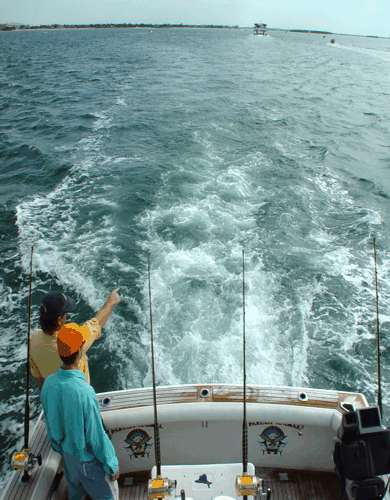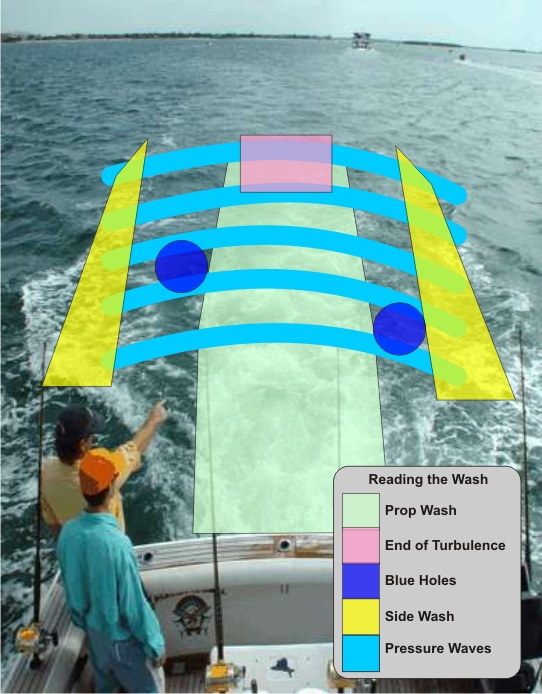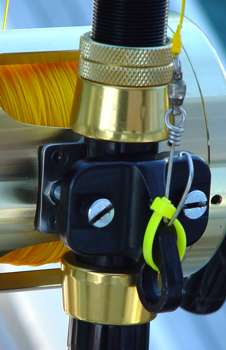02. Set Up Lure Pattern Training
Between The Lines - Ch 09: Running Lures
 There's a great deal that can be achieved by doing a set-up lure pattern practice run in calm sheltered waters such as a harbour or bay. It's time spent without any pressure to catch fish or get
There's a great deal that can be achieved by doing a set-up lure pattern practice run in calm sheltered waters such as a harbour or bay. It's time spent without any pressure to catch fish or get  things in order. It is the best place to break in a new crew that may or may not have done any of the previous exercises mentioned. Not so much to teach them how to fish or use the gear, but to teach and refresh the crew on the systems used on the boat, such as what happens when, where things go, and in what order. By running through the motions, improvements may be found and implemented.
things in order. It is the best place to break in a new crew that may or may not have done any of the previous exercises mentioned. Not so much to teach them how to fish or use the gear, but to teach and refresh the crew on the systems used on the boat, such as what happens when, where things go, and in what order. By running through the motions, improvements may be found and implemented.
It is also the time to try out new lures and even some old ones in different positions and at different speeds. These practice runs are also the place to put any new tackle through its paces. Often these runs highlight boat set-up changes that may be more efficient and this is the time to try out any modifications.
The most obvious is the prop wash, the churning whitewater extending from the back of the boat. It starts off quite deep at the props and tapers where it fades out on the surface. The churning of the water continues past the prop wash which is the area we call turbulence. A great place to put a lure is just where this ends.
Next to the prop wash are relatively clear lanes of water. Looking closer at these, you'll see they are not even - one has more consistent clarity with areas that are more open than the other side. These open areas are blue holes, which are also a great place to run lures.
Alongside the clear lanes is the side wash, which once again is not even. The end of these also is a great place to run lures. Quite simply and easily, we have worked out the general lure positions. To understand positions that are more specific we now look at the pressure waves. Try to get the lures as close to the desired placement as possible while positioning them on the lower third of the pressure waves.
Before running out any lures go through this exercise at varying speeds, for example at 6 and 8 knots and notice how the wash changes. Also, have a look at the effects of raising or lowering the trim tabs or engines, and if it's a small boat, weight distribution in the boat, which can also make a difference. You'll find the wash will change significantly at different speeds. It will also be affected by current and wind. Most calm water areas have some areas where the tide runs at a similar speed to waters you fish in so that you can see the difference in the wash going with and against the current.
By going through this exercise, you will have a pretty good idea of the best basic pattern for lures and positions and have an appreciation of how varying conditions affect your wash and that in turn alters the lure positions.
This is a practice run where everything should be positioned where it would be if you were out fishing. All checks such as rods, reels and drags should be done.
Select the lures you wish to run. This pattern may be based on previous experience, lures you wish to try out and lures you wish to compare with each other. This is a good time to go through the system of where things are put and the sequence of events, for example, lures may be placed on the gunwale as lures are too dangerous to ever be put on the deck. Then work out in which order the lures are deployed. On most boats, the longest lure positions are run out first and the shorter positions last. When retrieving the lures the reverse is the case, shorter in first, longest last.
Run through the lure check - leader, hook points and position of the hooks in the lure skirt. Then run the lure out making sure the reel is in control as a fish can strike at any time. Placing the thumb on the shoulder of the reel spool will stop overruns without burning your skin or the line.
Ensure the whole team complete procedures such as putting rubber bands on taglines the same way, which ones to use, and just as importantly, know why you chose to do things in certain ways. (Vid 1)
Vid 1 Deploy Lures
Once the pattern is set up go back through each lure and vary the position slightly to see how the lure behaves in different positions on the pressure waves. Do this by dropping the lure to the back of the pressure wave and winding it slowly forward. The lure will not often work properly on the back of the wave, it will likely bounce out at the top of the wave and will look best on the lower third of the face of the wave. (Vid 2)
Vid 2 Rubber Bands
With the lures set in position, you can now do some comparisons. Try running the same lure with a different leader set-up, or hook rig and run them next to each other, or try a different head shape. As discussed in the previous chapter adjusting the angle of entry will also change the lure's behaviour. It is certainly difficult to know exactly what a lure is doing when all you are seeing is the lure face at the surface. A different angle of view can be achieved by getting in a small boat and looking at the lure working side-on and directly above them. (Vid 3)
Vid 3 Lure Positions
Better still is a fish-eye view of the lures from under the surface using a trolling camera. (Vid 4)
Vid 4 Underwater View
Once you have one of the patterns positioned and running you can go to the next stage of developing the system by seeing how well you can manoeuvre the boat with the spread out the back. The ability to do a tight turn without tangling lines has many advantages, such as quickly getting to a feeding fish that has been spotted behind or to the side of the boat, and chasing a fish on a hot run before getting the rest of the pattern cleared. While doing the chapter on outriggers we realised that nearly every boat's shotgun set-up restricts the ability to turn as the lines cross over the riggers. The shotgun pole on our boat was then lengthened and angled back so the towing point was higher and behind the outriggers. The new set-up was then tested during one of these practice runs with great results. (Vid 5) During the turn, the lures will change their relative positions to pressure waves and side wash and have a tendency to bounce which can lead to lures tangling or hooks fouling on the leader. How fast you can turn without bouncing the lures is worth noting.
Vid 5 Check Pattern and Turn
During the exercises, you should still be discussing and implementing the systems to be used when you will be fishing. Large rods and reels can be intimidating as they are large and heavy. New anglers tend to use a power wind, using shoulders, elbows and rigid wrist movements when winding them regardless of how easy or hard it is to turn the handle. This is a great time to introduce some of the finer points such as speed winding. This is easily achieved by getting the elbow in line with the side of reel and turning the handle with a light wrist action. There are many instances when the faster you can wind the better it is, such as clearing the lures when another has hooked up when you need to keep a tight line on a fish when the boat is manoeuvring quickly on a fish on the surface and keeping a tight line on a fish swimming towards you. (Vid 6)
Vid 6 Check Pattern and Turn
During this exercise, you may also notice that it's much faster winding the lures in with the rods still in the holder until the lure is removed. Don't wind the swivel to the tip as it is too hard to get the swivel undone, rather wind it to within three or four feet, then disconnect the lure, do the snap back up and finally wind the swivel to the tip or put the swivel on a reel lug or loop. (Fig 4) Once the snap is secure put the lure and its leader somewhere safe where hooks can't catch on anything or anyone and where the leader cannot be walked on or get tangled around legs and gear. Having somewhere to put the gear not being used is one of the most important boats set-up considerations. It can be as simple as a fish box in a handy position. (Vid 7)
 |
|
| Vid 7 Speed Wind | Fig 4 |
The rods are the next items to get out of the way of the action. When the action is on, these should be stowed in a rocket launcher where they can't roll around damaging line or each other. (Vid 8)
Vid 8 Box Lures
Lures that are not for immediate use should also be stored in a lure roll or basket. Every boat has a system of handling lures and leaders. Once again each member of the team should know the preferred method of stowing lures and leaders. (Vid 9)
Vid 9 Stow Rods
As soon as practical lures should be stowed in a manner they can be put back into action as soon as possible (Vid 10)
Vid 10 Stow Lures
Once the boat is back at its base the crew should run through the washing and maintenance routine of the boat and gear, which areas get sponged, scrubbed or just sprayed. Lures should not be soaked in detergent, just rinsed and left to drain and dry in the shade before stowing away in lure bags or pouches. There are many systems that can be used such as just drying them on a towel, plastic draining trays or hung up in mesh lure rolls. Any lures that failed on the day and will be stored for long periods should be sprayed with silicone to preserve the skirts.
Practice runs are not just for novices. I still do them regularly before tournaments, at the start of the season and whenever we get a new team member. There is no better way of improving systems, getting enough information to base decisions on, or getting the boat, the gear and the crew all working together in harmony, more prepared to take advantage of that most important fish, the next one!
As it will be covered in detail, safety is not part of this page but it is certainly the most important drill that should always be done first.





